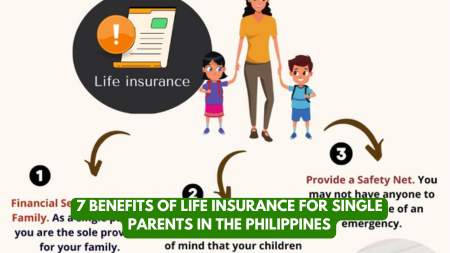No products in the cart.
Investment, Stock Market
8 Useful Ways Life Insurance Can Support Filipino Students’ Education
8 Useful Ways Life Insurance Can Support Filipino Students’ Education

Education is one of the most valuable assets a family can provide for their children, yet the rising costs of tuition, school supplies, and other educational expenses can pose a significant financial burden. Life insurance plays a crucial role in ensuring that, even in the face of unforeseen circumstances, a child’s education remains uninterrupted. It serves as a financial safety net, guaranteeing that monetary commitments, including school fees and related expenses, are met without constraint.
Beyond basic coverage, life insurance can be structured in multiple ways to support education funding, debt clearance, scholarships, student loan security, and long-term financial stability for students. Below are the comprehensive ways life insurance can be leveraged to ensure Filipino students have access to quality education without financial hardship.
1. Debt Clearance: Relieving Families from Financial Burden
One of the primary benefits of life insurance is its ability to provide liquidity for debt repayment. Many Filipino families take out loans or accumulate debt to fund their children’s education. In the unfortunate event of a parent’s passing, outstanding debts can become a significant financial strain. Life insurance ensures that:
- Existing loans, including personal and business debts, are settled.
- Family income remains available to cover education costs rather than being allocated to debt repayment.
- The child’s educational journey continues without financial interruption.
With financial obligations cleared, families can focus on providing the best possible education for their children without worrying about debt accumulation.
2. Education-Specific Life Insurance Policies
Certain education-focused life insurance policies are designed specifically to fund school fees, tuition, and other learning-related costs. These policies gradually build a cash value over time, which can be accessed to pay for:
- Elementary and high school fees in private institutions.
- Higher education tuition at colleges and universities.
- Supplemental education costs, including books, learning materials, and extracurricular activities.
These policies provide a structured savings plan that guarantees financial resources for a child’s educational needs at different stages of their academic journey.
3. Bursary and Scholarship Support Policies
Some life insurance policies allow policyholders to create bursary funds or scholarship endowments for educational institutions. This means:
- Financially disadvantaged students can receive educational assistance.
- Beneficiaries can be pre-determined, ensuring that financial support reaches those who need it most.
- Long-term educational funding can be established, securing grants and scholarships for future generations.
By integrating life insurance into scholarship and bursary programs, families can extend the benefits of their policy beyond their immediate circle, contributing to educational development in the Philippines.

4. Student Loan Security: Enhancing Access to Education Loans
Education loans are often necessary for Filipino students pursuing higher education, especially for those studying abroad or enrolling in specialized courses. Life insurance policies can be used as collateral for student loans, offering several benefits:
- Financial institutions are more likely to approve loans when backed by an insurance policy.
- Lower interest rates and better repayment terms may be offered.
- Parents and guardians gain assurance that loans will not become an unmanageable burden in case of unforeseen circumstances.
Using life insurance as loan security provides students with the flexibility to pursue quality education without the fear of financial roadblocks.
5. Child Welfare and Guardianship Protection
In cases where a parent passes away or becomes incapacitated, life insurance ensures that a child’s education is not compromised. These policies:
- Secure financial support for guardians or caregivers who assume responsibility for the child.
- Cover basic needs such as school fees, transportation, and daily allowances.
- Provide additional benefits for tuition, books, and extracurricular learning opportunities.
By establishing a child welfare fund through life insurance, families can guarantee that dependents continue their education even under difficult circumstances.
6. Special Needs Education Support
For children with special educational needs, additional financial resources may be required to support:
- Specialized learning programs.
- Therapies, medical interventions, and developmental support services.
- Assistive learning devices and personalized education plans.
Life insurance can be structured to provide long-term funding for these requirements, ensuring that children receive the necessary support to reach their full potential.
7. Creation of Emergency and Survival Funds
Life insurance serves as a reserve fund that can be accessed during emergencies, including:
- Medical emergencies that may impact a family’s ability to pay school fees.
- Unexpected economic downturns that could threaten financial stability.
- Tuition fee increases or other sudden educational expenses.
Having an education-focused life insurance policy in place provides reassurance that resources will be available when needed, regardless of financial uncertainties.
8. Generation-to-Generation Wealth Transfer
Beyond its immediate benefits, life insurance ensures long-term financial security for future generations by:
- Providing inheritance funds that can be used exclusively for education.
- Creating structured educational trusts that guarantee educational funding for children and grandchildren.
- Encouraging financial literacy and responsibility, as beneficiaries learn the importance of financial planning and wealth management.
This intergenerational financial planning approach ensures that quality education remains a priority in Filipino families for years to come.
Conclusion
Life insurance is a powerful and flexible tool that provides crucial financial support for education. By leveraging its many benefits, Filipino families can establish a solid financial foundation, ensuring that students have access to quality learning opportunities without interruption.
Whether through debt clearance, specialized education policies, bursary funds, student loan security, or long-term wealth transfer, life insurance plays a vital role in securing the academic success of Filipino students. By carefully selecting a life insurance policy that aligns with their financial goals, families can ensure that their children have the resources they need to pursue their educational aspirations and achieve their full potential.
Investing in life insurance today is an investment in the future of Filipino students—one that provides security, stability, and limitless opportunities for generations to come.
READ MORE RELATED BLOGS!
READ MORE AND SHARE!
TSOK Chronicles: Unleashing Passion, Dedication, and Excellence in 2024
2023 Your Practical Wedding Guide
Investments and Finance Ultimate Guide
If you like this article please share and love my page DIARYNIGRACIA PAGE Questions, suggestions send me at diarynigracia@gmail.com
You may also follow my Instagram account featuring microliterature #microlit. For more of my artworks, visit DIARYNIGRACIA INSTAGRAM


Peace and love to you.